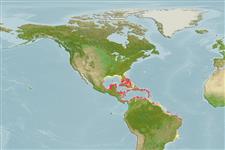Actinopterygii (ray-finned fishes) >
Perciformes (Perch-likes) >
Scaridae (Parrotfishes) > Scarinae
Etymology: Scarus: Greek, skaros = a fish described by anciente writers as a parrot fish; 1601 (Ref. 45335).
Environment / Climate / Range
Ecology
Marine; reef-associated; depth range 3 - 25 m (Ref. 9710). Subtropical, preferred ?; 33°N - 26°S, 98°W - 31°W
Western Atlantic: Bermuda, Florida (USA), Bahamas, and northeastern Gulf of Mexico to northern South America; throughout the Caribbean (Ref. 3802, 13628). Range probably extends to Brazil (Ref. 13628).
Length at first maturity / Size / Weight / Age
Maturity: Lm ?, range 16 - ? cm
Max length : 35.0 cm TL male/unsexed; (Ref. 9710); common length : 18.0 cm TL male/unsexed; (Ref. 3802)
Dorsal
spines
(total): 9;
Dorsal
soft rays
(total): 10;
Anal
spines: 3;
Anal
soft rays: 9. White stripe above upper dark stripe ends at gill opening; upper and lower caudal margins pale (Ref. 26938). Terminal phase males are blue-green and orange, chest and head pink below a green band at lower edge of eye; median fins with blue borders, the broad central parts orange with linear blue markings (Ref. 13442).
Found over shallow, clear waters, generally over Thalassia beds (Ref. 13628). Also found rocky or coral areas (Ref. 13628). A schooling species. Feeds on plants. A protogynous hermaphrodite (Ref. 55367). Super males spawn individually with striped females, while sexually mature males in the striped phase spawn in aggregation.
Life cycle and mating behavior
Maturity | Reproduction | Spawning | Eggs | Fecundity | Larvae
Diandric. Length at sex change = 9.6 cm TL (Ref. 55367). Forms harem groups composed of a single male and several smaller females (Ref. 55367).
Böhlke, J.E. and C.C.G. Chaplin, 1993. Fishes of the Bahamas and adjacent tropical waters. 2nd edition. University of Texas Press, Austin. (Ref. 5521)
IUCN Red List Status (Ref. 115185)
CITES (Ref. 94142)
Not Evaluated
Threat to humans
Reports of ciguatera poisoning (Ref. 30911)
Human uses
Fisheries: minor commercial; aquarium: commercial
More information
ReferencesAquacultureAquaculture profileStrainsGeneticsAllele frequenciesHeritabilityDiseasesProcessingMass conversion
Tools
Special reports
Download XML
Internet sources
